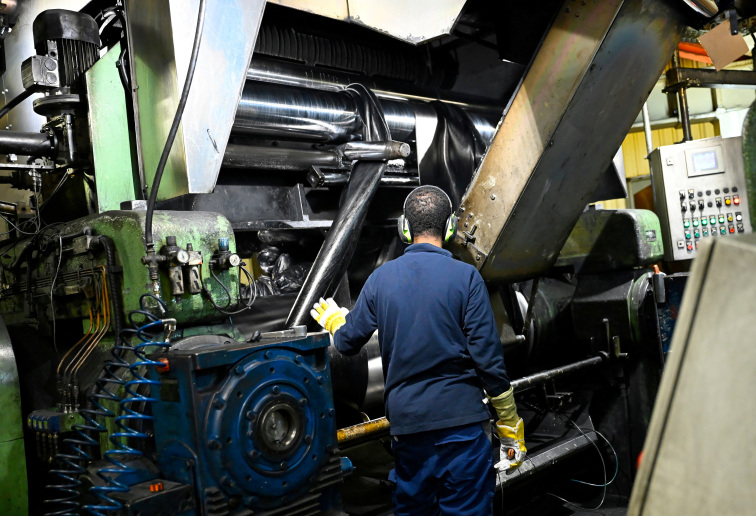A-shares plummeting: China's middle class faces impoverishment as the CCP struggles to prevent an impending crisis. (Video screenshot)
[People News] I. The Curtain of False Prosperity
Over the past year, China’s stock market seemed to have finally “revived.”
Major indexes rose together, margin financing balances soared past 2.4 trillion yuan, even surpassing the peak of the 2015 epic bubble. The media cheered, “Confidence has returned!” Policy interpretations flooded in: interest rate cuts by the central bank, lower reserve ratios, state-owned enterprise buybacks, securities firms increasing leverage—a seemingly nationwide “rescue feast.”
However, The Economist summed it up bluntly: “This is a paper wealth illusion.”
What’s rising are the indexes, not confidence; what’s hot are the trading chips, not real industries.
China’s capital market is using virtual prosperity to conceal real crises—bank bad debts, collapsing local government debt, and a second wave of real estate implosion.
II. Banks: The Hollowed-Out ATMs
A few years ago, bank deposit “disappearance” incidents erupted across provinces such as Henan and Liaoning, causing public outrage. Authorities later merged or shut down 290 high-risk banks and credit unions, seemingly to restore order but in truth merely delaying the inevitable blow-up.
Local governments have long treated banks as cash dispensers:
-
Fiscal shortfalls? Issue local bonds—banks foot the bill.
-
Real estate bailout? Launch “special loans”—banks cooperate.
-
Now, they even require banks to purchase local bonds to finance government housing and “affordable homes.”
But where does bank money come from?
Not from market profits, but from central bank relending and hidden liabilities. Behind the so-called “affordable housing” plan of 32 million units lies the reality that the financial system is being dragged into a policy quagmire. In an era of economic decline, banks’ net interest margins keep shrinking while bad assets pile up. This is not a rescue—it is a collective flight into the flames.
III. Stock Market: Fake Numbers, Real Risk
Since autumn 2024, the “index-pumping project” has been in full swing.
Regulators ordered listed companies to repurchase their own shares; state-owned firms under the SASAC were forced to enter the market to prop it up; the central bank injected liquidity to create a “confidence effect.”
The result? Margin-financing surged again, leverage ratios spiked, and retail investors revived their old fever for borrowing to speculate.
Yet, the core fundamentals remain unchanged:
-
Corporate fundraising capacity fell instead of rising—only 70 billion yuan raised from the stock market all year, less than 1% of capital demand.
-
Companies using internal cash to buy back shares boost prices temporarily but deplete future growth.
-
The financial sector’s nominal growth was 4%, yet commission revenues plunged 80% due to internal competition.
The capital market has become a self-entertaining stage, where inflated figures mask industrial decline.
IV. Real Estate: From Debt Restructuring to Debt Despair
The “three guarantees” policy—guaranteeing delivery, financing, and stability—came in waves, but the housing market remains cold.
Now it has entered a “second-round debt restructuring”, which really means the rebirth of debt:
In the past, only interest was extended; now, principal is slashed by 90%.
Giants like Country Garden are forced into “discount survival,” with creditors recovering less than 10%.
As property assets turn to rubble, some now pin hopes on “real-world asset tokenization (RWA)”—
turning unfinished buildings into blockchain tokens to sell to investors, fantasizing that Web3 can save the old economy.
But real estate’s essence is trust and cash flow, not tokens and blockchains.
Clearly, financial gimmicks cannot cure structural collapse.
V. A Nation Without Growth
In Zhu Rongji’s era, China used rapid growth to dissolve the “triangular debt” problem.
But today, the growth myth has ended.
When 5% of GDP is suspected to be fabricated, and when local debt, urban investment bonds, and property debt combine into a “domino inferno,” there is no longer double-digit growth to dilute the rot.
The IMF projects that by 2028, China’s growth will fall to 3.5%—too low to absorb new labor, too weak to maintain social stability.
The root cause lies in systemic overreach:
government dominance over markets, political control over banks, and policy manipulation of capital—
all to gain short-term “data victories” at the cost of long-term institutional decay.
VI. Conclusion: A Civilizational Faultline Beneath the Illusion
This wave of stock market rise looks like a rescue success, but it is in fact a symptom of deeper crisis.
When the economy shifts from creating value to manufacturing illusion,
when confidence stems not from institutions but from policy theatrics,
when capital markets become an extension of propaganda,
the very foundation of the future is being hollowed out by paper prosperity.
The real solution lies not in virtual rallies, but in genuine reform.
Trust must be rebuilt, institutions must be independent, and markets must be freed from political captivity.
Otherwise, every “rise” in the stock market is just another filter on a dream before the fall.
Final Note
History teaches that any prosperity maintained through money printing and market intervention always ends in deflation and a deeper crisis of trust.
True rejuvenation can only rest on the pillars of rule of law, freedom, markets, and innovation!
△











News magazine bootstrap themes!
I like this themes, fast loading and look profesional
Thank you Carlos!
You're welcome!
Please support me with give positive rating!
Yes Sure!